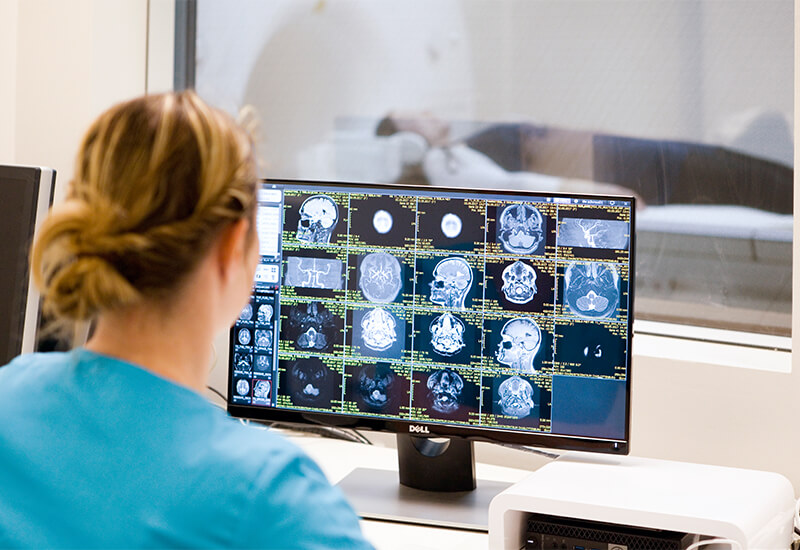An MRI can help with a wide variety of medical questions – and confirm suspicions or rule out diagnoses. For example, it helps to detect inflammatory diseases, changes in tissue, organs, bones, ligaments and tendons, or tumors/metastases. MRI can also be important in clarifying whether there is a disorder in the patient’s blood supply. In addition to its wide range of applications, however, the examination method has another major advantage: unlike other procedures, MRI does not use radiation that is potentially harmful to health.
The risks of ionizing radiation
Starting from the radiation source, radiation transports energy. This is transported as ionizing energy, for example, as in the case of X-rays. The energy transport is greater here than with visible light or with infrared radiation.
Ionizing radiation carries a risk: Matter penetrated by this type of radiation can be altered by it, as chemical bonds are broken or atoms as well as molecules are ionized. This means that one or more electrons are removed from an atom or molecule, leaving it as a positively charged ion (cation).
If ionizing radiation hits living cells or organisms, it is possible that damage is caused there by the corresponding chemical and physical processes. Examinations based on ionizing radiation (X-rays, X-ray fluoroscopy, and computer tomography) can cause damage to genetic material when it penetrates tissue. This damage to DNA is suspected of being harmful to health in the long term. Under certain circumstances, they can lead to cancer. Since it must be assumed that any radiation exposure may involve some risk, too frequent X-ray examinations and CTs (especially frequent repeat examinations that are not absolutely necessary) should be avoided.
Avoidance of ionizing radiation during MRI
As mentioned at the beginning, magnetic resonance imaging does not use ionizing radiation. Instead, it relies on three different fields to produce images:
Static magnetic field
MRI uses a strong, static magnetic field to generate what is known as nuclear magnetization. Many studies have been conducted on this, none of which have found any adverse health effects. The only possible risk lies in the magnetic attraction of metallic and ferromagnetic objects. They are strongly accelerated in the effective field of the magnet and can thus develop into dangerous projectiles. For this reason, there are no such objects in the MRI room. By carefully and comprehensively informing our patients and, if necessary, their accompanying persons, we can exclude any danger of our own from the body.
If a patient has had an operation involving the use of an implant (e.g., an orthopedic prosthesis), he or she will receive an implant card from his or her attending physician, which will indicate whether an MRI can be performed.

For example, hip and knee prostheses can usually be examined without hesitation. At most, the prostheses can lead to image restriction.
Unfortunately, wearers of pacemakers, insulin pumps, neurostimulators or cochlear implants cannot be examined with magnetic resonance imaging (or only with special clearance from the examining physician). Metal splinters in the facial area can also be critical. Furthermore, MRI cannot be performed if surgery has been performed on the cerebral vessels or if the ossicles in the tympanic cavity were surgically replaced some time ago.
Please let us know if you have any restrictions when you make your appointment.
High-frequency electromagnetic fields
Furthermore, MRI relies on so-called pulsed electromagnetic high-frequency fields, which excite the spin system. This can cause the patient’s body tissue to heat up by a maximum of 1 degree Celsius. However, there is a rapid, natural temperature equalization. Thus, there is no danger to health. In addition, complex monitoring systems ensure that the temperature or the degree of heating remains harmless during the examination.
Gradient fields
The third field required for successful magnetic resonance imaging is a so-called pulsed, weak magnetic field. It is called a gradient field. If it is switched very quickly, nerve or muscle cells in the patient’s body can be stimulated. As a result, contractions may occur in the chest, shoulder, hip, buttocks or nose. Heart palpitations are also possible. But don’t worry – a control system during MRI ensures that the gradient fields are not set too quickly and thus do not harm the patient.
MRI Frankfurt: Examination not harmful to health
As you can see, one of the great advantages of MRI examinations is that they are not harmful to health, since no ionizing radiation is used and thus the body is not stressed. In this way, even more frequent examinations are harmless.
Make your appointment now in the radiology practice of Dr. Catarina Jung!
Titelbild: elements.envato.com | © LightFieldStudios
Dear patients, you can book your desired appointment for an MRI examination at our practice in Frankfurt am Main easily and conveniently online at any time, even outside consultation hours. Benefit from flexible appointment times and book your appointment in just a few seconds.
